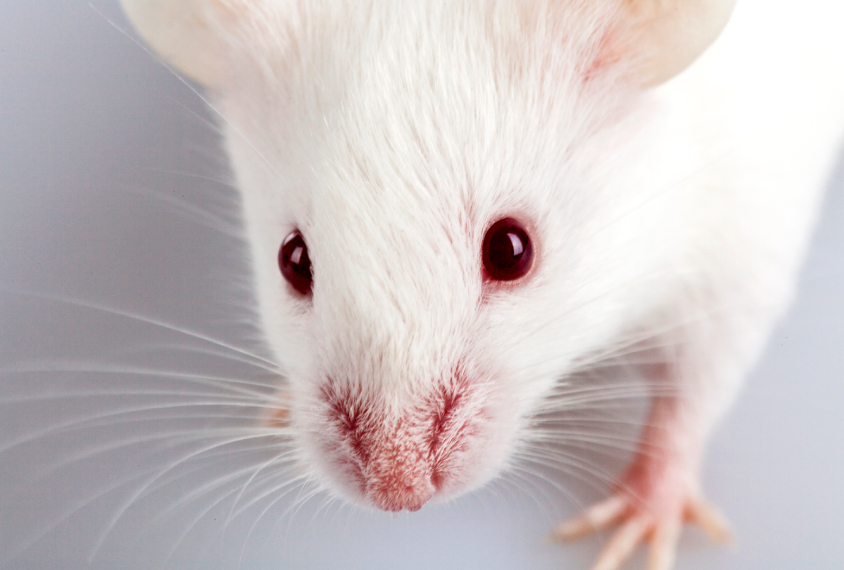
Sensory sensitivity in autistic people may stem from subset of neurons
Mice missing an autism gene called SHANK3 tend to be hypersensitive to touch, which may stem from underactivity of neurons that normally dampen sensory responses.
Mice missing an autism gene called SHANK3 respond to much lighter touches than typical mice do, according to a new study1. And this hypersensitivity seems to result from the underactivity of neurons that normally dampen sensory responses.
The study is the first to examine sensory sensitivity in mice missing SHANK3. Mice with mutations in other genes tied to autism, including MECP2 and GABRB3, have also been shown to be hypersensitive to puffs of air blown onto their backs.
Up to 90 percent of autistic people have sensory problems, including hypersensitivity to sensations such as sound or touch. These disruptions may underlie many of the difficulties autistic people face in navigating the world, says lead investigator Guoping Feng, professor of neuroscience at the Massachusetts Institute of Technology.
“Sensory overload is one of the reasons that autistic people cover their ears, [hide] in corners, want to be quiet,” Feng says. “It’s important to understand mechanisms.”
Up to 2 percent of people with autism have a mutation in SHANK3, which encodes a protein needed for neurons to communicate with one another2. Autism is also common in people with Phelan-McDermid syndrome, a condition caused by deletions of the chromosomal region in which SHANK3 is located.
Other experts also say the study underscores the importance of studying sensory problems in autistic people.
“Hyperreactivity to sensory input might be connected with autism in a really deep way,” says Sam Wang, professor of neuroscience at Princeton University, who was not involved in the work. “If sensory experience in the first few years of life is necessary for setting up a model of the world, an understanding of the world, then sensory processing would be a gateway to all kinds of other difficulties.”
Distinct neurons:
Feng and his team created mice missing the SHANK3 gene. They trained the mice to make a licking motion when they felt a touch on their whiskers; mouse whiskers give the animals important sensory information about their surroundings.
The mutant mice can sense much lighter touches on their whiskers than control mice can, the team found. This suggests the mutant mice’s sensory system is more sensitive than usual, Feng says.
The team then measured the activity of neurons in the mice’s somatosensory cortex, which receives and processes information from the whiskers.
Excitatory neurons in the mutant mice are overactive, the researchers found. The finding was initially surprising, given the gene’s role in neuronal communication, Feng says. Without SHANK3, the researchers would have expected these neurons to be less active than usual.
What’s more, inhibitory interneurons — which modulate other neurons’ activity — are less active in the mutant mice, the team found.
Inhibitory neurons signal through a chemical messenger called gamma-aminobutyric acid, which is thought to play an important role in autism.
The researchers then made mice lacking SHANK3 in only the inhibitory interneurons in the somatosensory cortex.
In these animals, the excitatory neurons retain normal levels of SHANK3 and are more active than in typical mice — and the mice still respond to lighter whisker touches than controls do.
By contrast, mice missing SHANK3 in only their excitatory neurons have less activity in those neurons and are less sensitive to whisker touches than controls are.
The findings suggest that reduced inhibition is what drives the mutant mice’s hypersensitivity, Feng says. They also reveal a specific cellular target for treating sensory problems.
“Correcting the inhibitory neurons may be the key to correct this sensory issue,” he says.
Connecting traits:
Previous work in other areas of the brain, such as the striatum, has found that SHANK3 decreases activity at excitatory synapses, says Jimmy Lloyd Holder, Jr., assistant professor of pediatrics, neurology and developmental neuroscience at Baylor College of Medicine in Houston, Texas, who was not involved in the work3.
“Pinpointing that this appears to initiate from inhibitory neurons of the cortex was surprising,” he says.
The signaling balance between excitation and inhibition is known to be disrupted in the brains of people with autism.
Wang says inhibitory neurons are known to be important for refining the brain’s responses to sensory stimuli, so it makes sense for them to be involved in autism. The new findings may help researchers understand the relationships within the “constellation” of autism traits, he says.
“Are there actually lines between the stars in the constellations?” Wang says. “Is there some causal relationship between this and other signs of autism?”
Feng says he next hopes to understand the best way to target inhibitory interneurons as a treatment for sensory problems, and to explore whether the neurons are involved in autistic people with other genetic mutations.
References:
Recommended reading

Developmental delay patterns differ with diagnosis; and more

Split gene therapy delivers promise in mice modeling Dravet syndrome

Changes in autism scores across childhood differ between girls and boys
Explore more from The Transmitter

Smell studies often use unnaturally high odor concentrations, analysis reveals

‘Natural Neuroscience: Toward a Systems Neuroscience of Natural Behaviors,’ an excerpt
